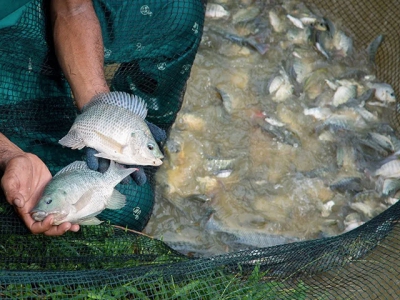Questions raised over cage cultures propensity to aggregate wild fish

The use of open net pen farms has been questioned in a new paper looking into their impacts on wild fish populations.
The researchers are concerned that the addition of open net pens could aggregate wild fish at the expense of fisheries in other parts of the water body. Photo © WorldFish
The authors of the study, which was undertaken around “an experimental tilapia farming structure” located on the Corvo River, in the Paranapanema River basin in Brazil, concluded that: “farming tilapia in cages profoundly altered the abundance and composition of the wild ichthyofauna, suggesting the need to propose effective regulations for such activities, including fisheries restrictions in farmed areas or even the prohibition of cage farming.”
The authors reached this conclusion having looked into the influence of cage aquaculture on the attraction and aggregation of wild fish over a 140 day period.
Samples were taken before and after farming began, with gillnets on the surface and near the bottom at distances from the cages ranging from 0 to 100, to 400m.
The effects of the food supply at two protein levels were also analysed, one containing 32 percen protein, the next 28 percent.
Changes in species richness and abundance were observed, with the number of individuals and the fish biomass increasing significantly just after the farming began. Some species, such as Iheringichthys labrosus, presented increased abundance near the cages, while others, such as Plagioscion squamosissimus, were more abundant far from the cages. Auchenipterus osteomystax was the most abundant species during the experiment, especially when the protein content of the pellets was higher.
The study was published under the title ‘Cage aquaculture in Neotropical waters promotes attraction and aggregation of fish’, was published in the latest issue of Aquaculture Research.
Có thể bạn quan tâm
 Vietnam requests Australia roll back ban on shrimp imports
Vietnam requests Australia roll back ban on shrimp imports The Vietnam government contends the ban by the Australian Department of Agriculture on raw imports is ‘causing serious damage’ to the country’s shrimp farmers
 China seen becoming Vietnam's largest tra fish importer
China seen becoming Vietnam's largest tra fish importer There is a high possibility that China could overtake the U.S. as the biggest importer of Vietnamese tra (pangasius) fish this year
 Tra fish export: China lucrative market but high risk
Tra fish export: China lucrative market but high risk China has become an increasingly lucrative market for Vietnam’s Tra fish (pangasius) but Vietnamese enterprises face risks in this market.
 Vietnamese tuna exports suffer from Japan’s high import tariff
Vietnamese tuna exports suffer from Japan’s high import tariff Vietnam’s tuna exports to Japan have dropped for four consecutive years since 2013 partly due to high import tariff at 6.4 percent – 7.2 percent.
 Australian ban on Vietnamese shrimp could drown exporters - trade official
Australian ban on Vietnamese shrimp could drown exporters - trade official Vietnamese shrimp exporters are facing losses and could go bankrupt following Australia's ban on imports of the crustacean, aimed at preventing white spot